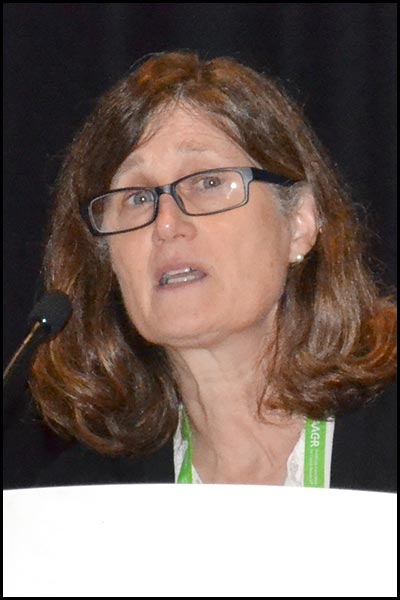Research advances in childhood cancers are leading to novel therapeutic approaches
A panel of pediatric cancer researchers discussed how recent discoveries in the areas of childhood leukemias, medulloblastoma, and rhabdomyosarcoma have the potential to change therapeutic paradigms for children with high-risk cancers during an symposium on Sunday, April 16.
The session, Pathogenesis of Childhood Cancers and Opportunities for New Therapeutic Approaches, can be viewed on the virtual meeting platform by registered Annual Meeting participants through July 19, 2023.

Sarah K. Tasian, MD, Chief of the Hematologic Malignancies Program and the Joshua Kahan Endowed Chair in Pediatric Leukemia at Children’s Hospital of Philadelphia and the University of Pennsylvania School of Medicine, discussed Philadelphia chromosome-like acute lymphoblastic leukemia (Ph-like ALL) and how its biology may inform precision medicine therapeutics.
“Ph-like ALL is a common subtype of B-cell-ALL, with increasing frequency across the age spectrum,” Tasian said. “Characterized by a kinase-activated gene expression profile and driven by a variety of genetic alterations involving cytokine receptors and kinases, Ph-like ALL is associated with high rates of residual disease and relapse in patients treated with conventional chemotherapy.”
Targeted inhibitor and chemo/immunotherapy approaches are currently under clinical investigation in children, adolescents, and adults with Ph-like ALL, including promising studies looking at the benefit of adding a tyrosine kinase inhibitor (TKI) during chemotherapy.
“Clinical diagnostics for Ph-like ALL are complicated, but getting easier,” Tasian said. “Studies have reported potent anti-leukemia activity of TKIs in preclinical ABL-class Ph-like ALL models, and there is a strong precedent of success with TKI-based therapies for analogous patients with Ph+ ALL.”

Jezabel Rodriguez-Blanco, PhD, Assistant Professor of Pediatrics at the Hollings Cancer Center and Darby Children’s Research Institute of the Medical University of South Carolina, described emerging mechanistic insights into brain tumor relapse in pediatric patients.
Pediatric brain tumors are the leading cause of cancer-related death in children, with medulloblastoma (MB) being the most common type, Rodriguez-Blanco said. Despite substantial progress, 30 percent of children with MB relapse.
“Recurrent disease in MB is commonly metastatic, and virtually none of these patients will live beyond the one-year hallmark,” Rodriguez-Blanco said. “These sobering statistics underscore the largely unmet need for brain tumor therapies aimed at treating or preventing the emergence of relapsed disease.”
Recent advances in the identification of treatment-resistant pools of stem-like brain tumor cells are providing important insight into the signaling mechanisms that allow these cell populations to evade therapeutics and expand, and may provide pathways for the development of targeted therapeutics.
“We know that we can either deal with relapsed medulloblastoma by preventing or treating the disease,” Rodriguez-Blanco said. “If we are trying to prevent, we have to make sure that the clinical trials are using compounds that are not just targeting the bulk in the tumor, but are also targeting these pools of stem-like cells that are allowing the tumors to come back. If it’s too late for prevention and we need to treat the disease, we need to make sure that the clinical trials are using the compounds that have shown efficacy in preclinical models.”

Corinne M. Linardic, MD, PhD, Associate Professor in the Departments of Pediatrics, Cell Biology, and Pharmacology and Cancer Biology at the Duke University School of Medicine and Duke Cancer Institute, reviewed multi-institutional efforts to generate new precision medicine tools for rhabdomyosarcoma (RMS).
“RMS is a cancer of skeletal muscle histogenesis and the most common soft tissue sarcoma of childhood,” Linardic said. “Despite decades of basic and clinical research, survival for patients with high-risk disease has not improved since the 1970s, remaining at less than 30 percent at five years.”
Genomic landscape studies have identified the most frequently occurring alterations, parsing out fusion-negative RMS driven by RAS pathway mutations, and fusion-positive RMS driven by signature fusion genes, including PAX3-FOXO1. However, this information has not translated into improved outcomes.
A number of ongoing research programs are working to change that, Linardic said, including two high-profile National Cancer Institute (NCI) programs — the NCI Fusion Oncoproteins in Childhood Cancers (FusOnC2) Cancer Moonshot program to target PAX3-FOXO1 and the NCI CCDI Molecular Characterization Initiative to analyze every child’s RMS tumor nucleic acids.
Additionally, she said that recent multidisciplinary international efforts have contributed to advances in the application of machine learning and the development of powerful new tools to inform precision diagnostics, risk stratification, and therapy.
“Deep learning uses diagnostic H&E [hematoxylin and eosin] images to identify RMS tumor features, predict the presence of known high-risk genomic changes, and assess risk,” Linardic said. “In the future, this may be integrated into clinical decision workflows, and may be especially useful in resource-limited regions.”
Register Today for the AACR Annual Meeting 2025
Don’t miss the most important cancer meeting of the year, April 25-30 in Chicago, Illinois. In-person and virtual registration packages include full access to live sessions, Q&A, networking, CME/MOC credits, and more.

